|
|
|
|
|
|
|
|
Collection
Mania
Text
and Photos by Maurice de Soissons
Europe’s antiques street
markets are where bargains can still be found.
|
|
In all European countries, the past 20 years have seen a huge
increase in street markets offering antiques, bric-a-brac, and a
wide range of decorative goods such as paintings, engravings, china
and brassware. In among the stalls are those selling junk, too, and
sometimes barely disguised modern reproductions of popular antique
pieces. Today the collector is almost overwhelmed at these markets
with too much to look at, too much to take in, and by the crowds
which often cram the space between stalls. But all this, in the end,
contributes to the excitement and interest, both for collectors and
for the many who come to wander through the markets enjoying the
animation, and the often larger-than-life dealers, and watch the
haggling—almost invariably conducted at a gentlemanly pace,
without raised voices—which is the usual way to proceed. |
|
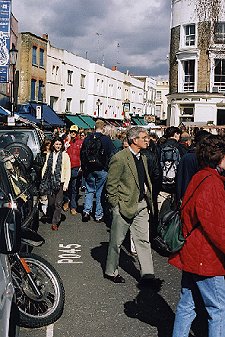 |
| Every
Saturday of the year, Portobello Road in London—reputed to
be the world’s largest antiques market—is crowded with
visitors. |
|
 ania for collecting has
sometimes been likened to the primitive urges of the
hunter-gatherer, before settled farming diminished his usefulness to
family and community. Certainly the quest is there, and the search
and the hunt. Nowadays the collector goes far beyond the mere
decoration of his home. Often whole rooms, perhaps several rooms,
are devoted to a collection and even to entire dwellings, with, for
instance, teapots, toy soldiers, model railways, or silverware. ania for collecting has
sometimes been likened to the primitive urges of the
hunter-gatherer, before settled farming diminished his usefulness to
family and community. Certainly the quest is there, and the search
and the hunt. Nowadays the collector goes far beyond the mere
decoration of his home. Often whole rooms, perhaps several rooms,
are devoted to a collection and even to entire dwellings, with, for
instance, teapots, toy soldiers, model railways, or silverware.
Markets have
been with mankind since the dawn of time, no doubt. And centuries
ago, mixed with the vegetables, fruit, meat, cheese and fish, were
the occasional stalls selling clothing, furniture, tools, pots and
pans, and other utilitarian domestic goods. But only with relative
affluence for a far greater proportion of a population in the last
50 years, have the antiques street markets of Europe grown to their
present-day size and attraction.
They
do not appear to detract from the antiques shops, and indeed many
stalls are run by dealers with their own shops, often close by the
market. The old commercial adage that similar shops should be close
together so that a prospective customer can have the best of
choices, seems to be put into practice with the juxtaposition of
market stall and shop. Yet many of the stall holders are those
peripatetic traders who move from one market to another, who buy at
auctions and at house sales. They often trade stock early in the day
with their neighboring dealers before the main wave of collectors
descends on the stalls.
|
|
 uite often these antique
markets are part of bigger markets where more general domestic
requirements are on display. The sellers of perishable products
needing to be sold immediately and consumed within a few days, are
almost always loud in their praises of their
peaches or cabbages, especially as the time for the close of
the market draws near. The antiques dealers are a different breed.
Their wares will not deteriorate and will just have to be packed up
and taken away to the stall holder’s shop or be stored ready for
the next market. uite often these antique
markets are part of bigger markets where more general domestic
requirements are on display. The sellers of perishable products
needing to be sold immediately and consumed within a few days, are
almost always loud in their praises of their
peaches or cabbages, especially as the time for the close of
the market draws near. The antiques dealers are a different breed.
Their wares will not deteriorate and will just have to be packed up
and taken away to the stall holder’s shop or be stored ready for
the next market.
Having
enough money and time to indulge in collecting has produced
increasing numbers of private people with special, fairly narrow
areas of expertise. These may be in old prints or Chinese porcelain,
in 19th-century jewelry or pewterware, in model cars or
old cameras. It is largely these people, as well as the dealers
going the rounds of the stalls, who with their particular knowledge
are always hoping for a bargain. Hoping to find an item which has
not been recognized for what it is and for which the asking price is
a fraction of its true value. And sometimes bargains really are
found. The stories abound—of a “costume” brooch of supposed
colored glass turning out to be garnets and diamonds after careful
cleaning, of a painting left to molder in an attic, brought out for
sale on a “junk” stall, being by a well-known 16th-century
Italian painter. Sometimes the stories are less dramatic as to price
differential, but usually the modest outlay turns into a substantial
gain. So, buoyed by these stories, collectors go on searching and
hoping.
|
 |
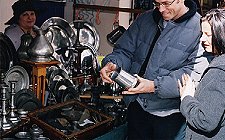 |
| Specialist
stalls abound in the Portobello market. Here old and modern
pewterware catch the eye of a visitor and his wife. |
|
|
 |
| Collectors
of toy soldiers hover round this Portobello stall where
examples from the early 20th century are on display. |
|
 aris,
Rome, Madrid and many provincial cities in Europe have antiques
street markets to gladden the hearts and sharpen the wits of
collectors, and afford entertainment to the many people who come
just as onlookers to wander among the stalls and watch the action of
dealing in a huge variety of wares. Belgium’s capital, Brussels,
has two renowned markets, the one that takes place on Saturdays and
Sundays, the other on every day of the week. They are very different
in atmosphere, and in the content and quality of the wares on offer. aris,
Rome, Madrid and many provincial cities in Europe have antiques
street markets to gladden the hearts and sharpen the wits of
collectors, and afford entertainment to the many people who come
just as onlookers to wander among the stalls and watch the action of
dealing in a huge variety of wares. Belgium’s capital, Brussels,
has two renowned markets, the one that takes place on Saturdays and
Sundays, the other on every day of the week. They are very different
in atmosphere, and in the content and quality of the wares on offer.
The antiques market of the Sablon is the up-market venue for
Saturdays and Sundays. This takes place in the Place du Grand Sablon,
quite close to the Place Royale, the great art museums and the
imposing Palais de Justice. The Sablon claims to be the oldest
antiques market in Europe, and many of its stalls are run by
independent dealers without antiques shops, although the Sablon area
has dozens of these, including
a “hypermarket” with permanent stalls or small shops. There are
numbers of shops specializing in Art Noveau objets d’art
for which Brussels is famous.
The
Sablon market has the advantage of not being too large and therefore
not overwhelming in choice. Dealers in books, oil paintings,
watercolors, and prints, in French porcelain, pottery and silverware
offer a good balance of articles at a range of prices from the
modest to the expensive. Rugs, brassware, lamps, bric-a-brac of many
different qualities and themes are to be found there. The stalls are
all well covered so that inclement weather is not too much of a
bother.
|
|
 own the
hill, an easy 10 minutes’ walk from the Sablon is the market of
the Marolles district spread over the large area of the Place du Jeu
de Balle. This is variously known as Le Vieux Marché (the Old
Market) or Le Marché aux Puces (the Flea Market). The latter is
quite a common name for markets offering the lower end of the
bric-a-brac trade and is often, as in this case, mixed up with
clothing, light fittings, kitchenware and other domestic needs.
Visitors are often amazed at the ugliness and the usefulness of some
of the items on offer. Nevertheless, the sheer variety of offerings,
the noise of the multicultural dealers and buyers, the animation of
the crowds, particularly at the weekends and when the sun shines,
are a tonic for any visitor to Brussels. Bargains have certainly
been found here, but collectors have to search long and hard and
perhaps over several visits to find one. Bargaining on price is
normal and expected here, as indeed everywhere in the street
markets, with French and Flemish (Dutch) the normal languages in
both Brussels markets. English is spoken by most dealers. own the
hill, an easy 10 minutes’ walk from the Sablon is the market of
the Marolles district spread over the large area of the Place du Jeu
de Balle. This is variously known as Le Vieux Marché (the Old
Market) or Le Marché aux Puces (the Flea Market). The latter is
quite a common name for markets offering the lower end of the
bric-a-brac trade and is often, as in this case, mixed up with
clothing, light fittings, kitchenware and other domestic needs.
Visitors are often amazed at the ugliness and the usefulness of some
of the items on offer. Nevertheless, the sheer variety of offerings,
the noise of the multicultural dealers and buyers, the animation of
the crowds, particularly at the weekends and when the sun shines,
are a tonic for any visitor to Brussels. Bargains have certainly
been found here, but collectors have to search long and hard and
perhaps over several visits to find one. Bargaining on price is
normal and expected here, as indeed everywhere in the street
markets, with French and Flemish (Dutch) the normal languages in
both Brussels markets. English is spoken by most dealers. |
 |
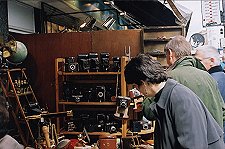 |
| Among
the Portobello stalls of general bric-a-brac, porcelain and
jewelry, is this seller of classic mechanical cameras. |
|
|
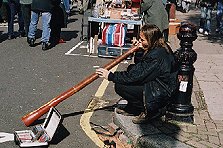 |
| Musical
entertainment for the Portobello crowds from a young man
playing a digeridoo, the Australian aboriginal instrument. |
|
|
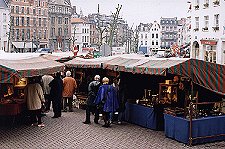 |
| In
Brussels, the Saturday market at the Place du Grand Sablon
is a must for visiting antiques collectors. |
|
 ver in
London, the city’s Portobello antiques street market is billed as
the world’s largest. Portobello Road is situated in the Notting
Hill area and is easy to find by Underground to Notting Hill Gate
and Ladbroke Grove. It is about one and one-half miles from Marble
Arch. The largest antiques street market it must be, for there are
1,500 dealers who regularly use stalls lining the Portobello Road
and into Westbourne Grove, and/or have shops or stalls in
mini-hypermarkets in the streets. Shops fronting the streets spill
over onto the pavements on market days. The market is every Saturday
of the year beginning about 5:30 in the morning, which is when other
dealers from Britain and overseas tend to come, before the main
press of visitors. The shops are open six days a week. ver in
London, the city’s Portobello antiques street market is billed as
the world’s largest. Portobello Road is situated in the Notting
Hill area and is easy to find by Underground to Notting Hill Gate
and Ladbroke Grove. It is about one and one-half miles from Marble
Arch. The largest antiques street market it must be, for there are
1,500 dealers who regularly use stalls lining the Portobello Road
and into Westbourne Grove, and/or have shops or stalls in
mini-hypermarkets in the streets. Shops fronting the streets spill
over onto the pavements on market days. The market is every Saturday
of the year beginning about 5:30 in the morning, which is when other
dealers from Britain and overseas tend to come, before the main
press of visitors. The shops are open six days a week.
While
there are many general bric-a-brac stalls in the market, Portobello
is famous for the huge range of specialist stalls and shops. There
appears to be a good deal of new or reproduction wares, and the
would-be collector should be cautious and ask questions of their
relative age and provenance. Equally, there is a vast array of old
antiques whose genuine qualities can be upheld with documentation.
The Portobello Road Antiques Dealers Association does all it can to
promote fair dealing between its members and the public.
Apart
from the bric-a-brac stalls, there are specialist dealers in toy
soldiers, old books and prints, landscape paintings, silverware and
pewterware. A collector of Chinese porcelain can find much of
interest, as can someone who wants English Staffordshire
pottery figures. There is a clock center. A stall sells a range of
the old classic mechanical cameras in full working order. Textiles,
jewelry of all kinds and prices, compasses and telescopes, and
scientific instruments are on offer from the stalls. Glass and
crystalware from Georgian and Victorian times and many other styles
are displayed. There are dealers in what are just labeled
“collectibles” which show a catholic taste and an interesting
variety of wares.
Always
in Portobello Road, as in the Brussels antiques street markets,
there is the human interest element of dealers, collectors, bargain
hunters and visitors. Perhaps Portobello has a wider selection of
nationalities and languages jostling together, talking on mobile
telephones, calling to friends. For these markets are without doubt
also tourist attractions which bring people just to look and enjoy
the atmosphere. And perhaps some of them will be bitten by the
collecting bug. |
|
When in London, you can use your Bankard MasterCard, Bankard Visa or Bankard
JCB.
|
|
|
|
|
|
|





